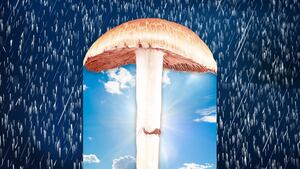From the outside, not much happens during a session of psychedelic-assisted therapy. For roughly six hours, the patient lies on a bed with eye shades and headphones on. The therapist sits by their side, on-call in case something comes up. But really, all of the action takes place internally where the patient is alone in their own world—except for the music.
Over the past few years, psychedelic-assisted therapy has emerged as one of the most promising new treatments for depression. A study published in April in the New England Journal of Medicine found that psilocybin, the psychoactive ingredient in hallucinogenic mushrooms, was more effective at reducing people’s symptoms than a traditional antidepressant drug. Scientists aren’t exactly sure how psychedelics have this antidepressant effect, but they think it’s a combination of the drugs’ pharmacological properties (they act on the same neurochemical, serotonin, that traditional antidepressants do) and people’s subjective experiences while they’re tripping.
Since the birth of psychedelic-assisted therapy in the 1950s, music has been a key component of this experience. Oftentimes it’s the only sensory input the person has for many hours. It’s become so important that researchers have dubbed it “The Hidden Therapist” because of its ability to influence a patient’s emotional state and even the overall success of this type of therapy.
Consequently, as psychedelic therapy has gained more acceptance and gone more mainstream, researchers have accelerated efforts into investigating how it works and finding ways to improve its effectiveness—including what the most optimal music is for patients to listen to during sessions. Artists are responding in kind by developing music specifically for the experience. In November, the musician Jon Hopkins, who produces everything from classical piano to electronic dance music, released the first album created specifically for psychedelic therapy. Hopkins had been assisting in the musical selection for psychedelic clinical trials at Imperial College London, and he has told the public that experience, as well as his own psychedelic use, partly inspired the album.
“For me, it’s incredibly spiritual, but it’s the spirit of nature,” said Rosalind Watts, the former clinical lead of the psilocybin for depression trial at Imperial, during a Spotify Greenroom panel about the album. “It’s so beautifully combined together in this seamless gentle form that I think, as a guide, it would just be such a pleasure to work with.”
Fine Tuning the Mind
Neuroscientists think that one of the primary ways psychedelics act on the brain is by inhibiting normal, default activity. Two areas that are affected, the medial prefrontal cortex and the precuneus, typically suppress and control emotional experiences. When these areas are quieted during a psychedelic trip, it allows mundane activities to feel profound. Even the most boring experiences can suddenly become meaningful and life-altering.
At the same time, these drugs are also activating tons of neurons throughout the brain—ones that might not normally fire together. This results in a “freer” or “more anarchic and less organized” kind of brain activity, according to neuroscientist Mendel Kaelen, the founder and CEO of Wavepaths, an app that creates music for psychedelic therapy.
This exotic brain chemistry seems to especially enhance the emotional effects of music when combined with psychedelic drugs. “We know that music can be emotionally evocative. It's an extremely powerful tool for channeling or harnessing emotion, and so the idea is that this is amplified with psychedelics,” Matthew Johnson, a professor of psychiatry and behavioral sciences at Johns Hopkins University, told The Daily Beast. “They can act interactively and perhaps synergistically to create meaningful experiences.”
Through the emotional quality of music, therapists can direct what can otherwise be a very uncertain and aimless experience. Psychedelics can cause people to feel a dissolution of time and space, or even their sense of self. “In the dissolvement of all of these different structures, music provides a new kind of structure,” said Kaelen.
More practically, music offers the patient a constantly evolving experience. It changes tempo and rhythm and can take the listener to new places in their head. Other forms of art might be emotionally evocative at first, but even someone on mushrooms is bound to get bored of looking at the same painting for six hours.
When it comes to picking the right music to accompany a trip, professionals usually default to classical music. In many ways, that makes sense. There are no lyrics to distract you. It can be soft and calming or powerful and intense, and it can fade into the background if you need.
However, both Kaelen and Johnson think that the reason it’s traditionally been used is less intentional; most likely, therapists in the 1950s just liked listening to it, so they used it during their sessions.
Psychedelic researchers have started experimenting with other types and qualities of music to see if something else might work better. In a small peer-reviewed study published last year, Johnson compared LSD-users’ responses to traditional classical music versus a playlist of non-Western songs that were less melodic and featured instruments with heavy overtones, like Tibetan singing bowls, gongs, didgeridoo, chimes, and sitar. To his surprise, he found that 60 percent of participants preferred non-Western music over the classical playlist while they tripped.
One potential explanation is that the Western music may have been too emotionally evocative for some people. Most psychedelic therapy playlists follow the arc of a calm, gentle start as the drug kicks in, building up to more intense music while the psychedelic has its peak effects, followed by a gradual return to softer music during the comedown.
However, there can be dramatic fluctuations in people’s emotions during that journey, ranging from happiness and ecstasy to fear and sadness. Research Kaelen published earlier in his career at Imperial showed that people undergoing psychedelic-assisted therapy were more receptive to music that matched their emotional experience as they tripped. More importantly, they also had a greater reduction in depression symptoms. If the music conflicted with what they were feeling, they resisted it and their therapeutic outcomes suffered.
“With classical [music], given that there’s a melodic structure, you’re taking a chance—it may really help or it may not, depending on that particular match at any given moment,” Johnson said. “Perhaps a less melodically structured music or sound is going to be less variable in that sense in terms of mismatching where people are at emotionally.”
Another potential reason for people’s preference for non-Western music is the qualities of the sound itself. Tone color (also known as timbre, or the sound quality of a musical note) is the key feature in music that conveys emotionality. It’s also used to identify different voices and musical instruments. How you distinguish a violin from a guitar, or an angry voice from a happy one, is through tone color.
In an unpublished study involving participants on LSD, Kaelen said he found that areas of the brain involved in processing language and emotion exhibited higher activity in response to music that had more complex tone color (like heavy overtones). The more activity in the brain, the stronger the emotional response to the music.
Kaelen said the study suggests that “in a psychedelic state, the brain is reallocating more resources to process the features of tone color in sound.” And because the brain is paying more attention to the emotional component of the music, the music is perceived as being more emotional.
Hopkins’ new album, appropriately titled Music for Psychedelic Therapy, is ambient electronic music. The tracks have little rhythm or melody to them, instead integrating recordings from caves and jungles with reverberating electronic tones. Each song flows into the next without clear breaks or melodic changes, although the music does gradually swell and fade as it progresses. The music doesn’t evoke a particular emotion but instead feels ambiguously spiritual.
That may seem to be the point. Psychedelic experiences are often intensely spiritual or mystical for people. In one study from Johns Hopkins University on psilocybin use, one-third of participants said their first time taking the drug was the most spiritually significant experience of their life; two-thirds said it was in their top five, ranking it alongside the birth of a child or the death of a parent. Music that enhances that intense mystical feeling, but without inducing overtly positive or negative emotions, could be especially therapeutically powerful for patients.
Even music specifically created for psychedelic therapy might not work for everyone, though. Kaelen says that, at the end of the day, “There is no and there will never be the perfect playlist for psychedelic therapy because music is something very personal.”







